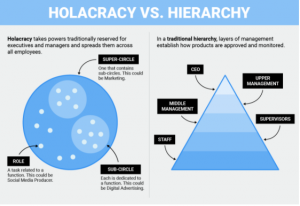Before we delve into whether or not holacracy is right for your organization, how many of us know what holacracy is? Holacracy is a social technology or system of organizational governance in which authority and decision-making are distributed throughout a holarchy of self-organizing teams rather than being vested in a management hierarchy. In theory, holacracy empowers people to make meaningful decisions and drive change.
Instead of a traditional management structure where questions must go from the bottom to the top and decisions go in reverse, organizations that adopt holacracy empower agile teams of people to make and implement decisions.
Self-organization models typically share three characteristics:
Teams are the structure
In holacracy, there are “circles” or many companies simply call them “teams.” Whatever they’re called, these basic components are not, individuals, and not units, departments, or divisions but they are the essential organizational building blocks. Individual roles are defined and assigned in order to accomplish the work. As in more traditional hierarchical organizations, there may be different teams for different projects or functions like finance, tech, sales. But self-managing enterprises have a lot more of them. After Zappos implemented holacracy, 150 departmental units evolved into over 500 circles.
Teams design and govern themselves
Although self-organizing companies try to avoid the traditional hierarchy, the teams are a part of a larger structure, which they are actually able to shape and refine. Holacratic organizations have everyone sign a constitution—a document outlining the rules by which circles are created, changed, and removed. So the circles not only manage themselves; within those guidelines, they also design and govern themselves. The constitution doesn’t dictate exactly how people should do their tasks. It explains in a broad way how circles should be created and operate: how they should assign roles, what boundaries the roles should have, and how the circles should interact with one another.
Leadership is constantly changing
In self-managed organizations, leadership is distributed among roles, not individual people. People usually hold multiple roles, on multiple teams. Leadership responsibilities continually change as the work changes and as teams create and define new roles. Technology is essential for keeping all these changes straight. The information is accessible to anyone in the organization and each individual’s commitments are visible to everybody at the company. Supposedly, transparency enables cross-team integration.
Although it is becoming a buzz word, holacracy is not being adopted at a rapid pace. The organizations who have tried to adopt it run into a myriad of issues, including increased turnover and decreased productivity given the endless meetings. While some look at it with interest, others simply say it does not work. Next week we will delve into some of the issues that have arisen when organizations have tried to implement holacracy.

